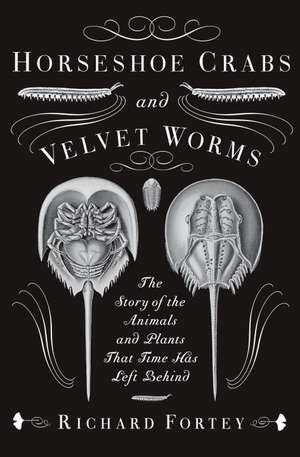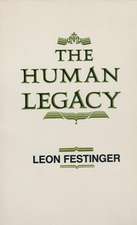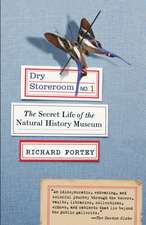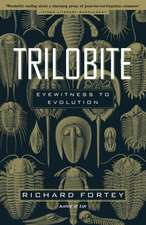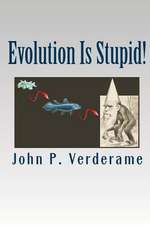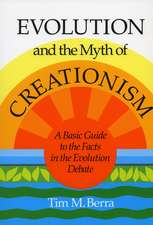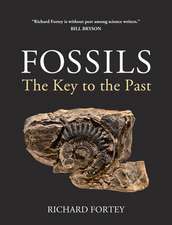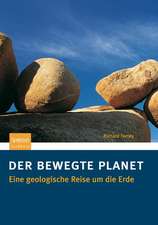Horseshoe Crabs and Velvet Worms: The Story of the Animals and Plants That Time Has Left Behind
Autor Richard Forteyen Limba Engleză Paperback – 10 dec 2012
Scattered across the globe, these remarkable plants and animals continue to mark seminal events in geological time. From a moonlit beach in Delaware, where the hardy horseshoe crab shuffles its way to a frenzy of mass mating just as it did 450 million years ago, to the dense rainforests of New Zealand, where the elusive, unprepossessing velvet worm has burrowed deep into rotting timber since before the breakup of the ancient supercontinent, to a stretch of Australian coastline with stromatolite formations that bear witness to the Precambrian dawn, the existence of these survivors offers us a tantalizing glimpse of pivotal points in evolutionary history. These are not “living fossils” but rather a handful of tenacious creatures of days long gone.
Written in buoyant, sparkling prose, Horseshoe Crabs and Velvet Worms is a marvelously captivating exploration of the world’s old-timers combining the very best of science writing with an explorer’s sense of adventure and wonder.
Preț: 127.59 lei
Nou
Puncte Express: 191
Preț estimativ în valută:
24.42€ • 25.40$ • 20.16£
24.42€ • 25.40$ • 20.16£
Carte disponibilă
Livrare economică 24 martie-07 aprilie
Preluare comenzi: 021 569.72.76
Specificații
ISBN-13: 9780307275530
ISBN-10: 0307275531
Pagini: 384
Ilustrații: 24 PP B&W
Dimensiuni: 132 x 203 x 18 mm
Greutate: 0.36 kg
Editura: Vintage Publishing
ISBN-10: 0307275531
Pagini: 384
Ilustrații: 24 PP B&W
Dimensiuni: 132 x 203 x 18 mm
Greutate: 0.36 kg
Editura: Vintage Publishing
Notă biografică
Richard Fortey was a senior paleontologist at the Natural History Museum in London until his retirement in 2006. He is the author of several books, including Fossils: The Key to the Past; The Hidden Landscape, which won the Natural World Book of the Year in 1993; Life: A Natural History of Four Billion Years of Life on Earth; Trilobite!, which was short-listed for the Samuel Johnson Prize; Earth: An Intimate History; and Dry Storeroom No. 1: The Secret Life of the Natural History Museum. He has won the Lewis Thomas Prize for Writing About Science from Rockefeller University and the Michael Faraday Prize from the Royal Society. He was president of the Geological Society of London during its bicentennial year in 2007 and is a Fellow of both the Royal Society and the Royal Society of Literature. He lives in Oxfordshire.
Extras
PROLOGUE
These anomalous forms may almost be called living fossils; they have endured to the present day, from having inhabited a confined area, and from having thus been exposed to less severe competition.
—Charles Darwin: The Origin of Species
Evolution has not obliterated its tracks as more advanced animals and plants have appeared through geological time. There are, scat- tered over the globe, organisms and ecologies which still survive from earlier times. These speak to us of seminal events in the history of life. They range from humble algal mats to hardy musk oxen that linger on in the tundra as last vestiges of the Ice Age. The history of life can be approached through the fossil record; a narrative of forms that have vanished from the earth. But it can also be understood through its survivors, the animals and plants that time has left behind. My intention is to visit these organisms in the field, to take the reader on a journey to the exotic, or even everyday, places where they live. There will be landscapes to evoke, boulders to turn over, seas to pad- dle in. I shall describe the animals and plants in their natural habitats, and explain why they are important in understanding pivotal points in evolutionary history. So it will be a journey through time, as well as around the globe.
I have always thought of myself as a naturalist first, and a palaeon- tologist second, although I cannot deny that I have spent most of my life looking at thoroughly dead creatures. This book is something of a departure for me, with the focus switched to living organisms that help reveal the tree of life (see endpapers). I will frequently return to considering fossils to show how my chosen creatures root back into ancient times. I have also broken my usual rules of narrative. The logical place to start is at the beginning, which in this case would mean with the oldest and most primitive organisms. Or I could start with the present and work backwards, as in Richard Dawkins’ The Ancestor’s Tale. Instead, I have opted to start somewhere in the mid- dle. This is not perversity on my part. It seemed appropriate to start my exploration in a place, biologically speaking, that is familiar to me. The ancient horseshoe crabs of Delaware Bay were somehow fit- ting, not least on account of their trilobite connections. Amid all the concern about climate change and extinction, it is encouraging to begin with an organism whose populations can still be counted in their millions. From this starting point somewhere inside the great and spreading tree of life I can climb upwards to higher twigs if I wish, or maybe even delve downwards to find the trunk. Let us begin to explore.
These anomalous forms may almost be called living fossils; they have endured to the present day, from having inhabited a confined area, and from having thus been exposed to less severe competition.
—Charles Darwin: The Origin of Species
Evolution has not obliterated its tracks as more advanced animals and plants have appeared through geological time. There are, scat- tered over the globe, organisms and ecologies which still survive from earlier times. These speak to us of seminal events in the history of life. They range from humble algal mats to hardy musk oxen that linger on in the tundra as last vestiges of the Ice Age. The history of life can be approached through the fossil record; a narrative of forms that have vanished from the earth. But it can also be understood through its survivors, the animals and plants that time has left behind. My intention is to visit these organisms in the field, to take the reader on a journey to the exotic, or even everyday, places where they live. There will be landscapes to evoke, boulders to turn over, seas to pad- dle in. I shall describe the animals and plants in their natural habitats, and explain why they are important in understanding pivotal points in evolutionary history. So it will be a journey through time, as well as around the globe.
I have always thought of myself as a naturalist first, and a palaeon- tologist second, although I cannot deny that I have spent most of my life looking at thoroughly dead creatures. This book is something of a departure for me, with the focus switched to living organisms that help reveal the tree of life (see endpapers). I will frequently return to considering fossils to show how my chosen creatures root back into ancient times. I have also broken my usual rules of narrative. The logical place to start is at the beginning, which in this case would mean with the oldest and most primitive organisms. Or I could start with the present and work backwards, as in Richard Dawkins’ The Ancestor’s Tale. Instead, I have opted to start somewhere in the mid- dle. This is not perversity on my part. It seemed appropriate to start my exploration in a place, biologically speaking, that is familiar to me. The ancient horseshoe crabs of Delaware Bay were somehow fit- ting, not least on account of their trilobite connections. Amid all the concern about climate change and extinction, it is encouraging to begin with an organism whose populations can still be counted in their millions. From this starting point somewhere inside the great and spreading tree of life I can climb upwards to higher twigs if I wish, or maybe even delve downwards to find the trunk. Let us begin to explore.
Recenzii
"Mr. Fortey is as vivid and charming about live things as he's long been about dead ones, perhaps even more so. Reading this book is like stepping into the field with a man who's equal parts naturalist and poet, equal parts E.O. Wilson and Paul Muldoon. It's a bewitching combination . . . You begin to love Mr. Fortey as much as he loves horseshoe crabs. You want to throw him over your shoulder, like a big stuffed animal won at a fair, and lug him home to explain the mysteries of your backyard . . . His book is not only well built and witty but emotionally profound too . . . an inducement to be as awake and observant as possible." —The New York Times
"A lively writer with a penchant for slightly goofy jokes, a vast storehouse of arcane knowledge, and an inexhaustible fund of enthusiasm for his subject, Fortey is the perfect interpreter and guide to the marvels and mysteries of archaic existence." —The Boston Globe
"[A] delightful account . . . even those squeamish about worms will find Fortey’s enthusiastic excavations charming." —PW (starred)
"In this fascinating, well-written book, [Fortey] offers a worldwide tour of places whose lands and waters shelter extraordinary forms of life that have overcome mass extinctions, sea-level changes, ice ages and other obstacles to survive into the present. Taking great joy in his trip back in time, Fortey plays both adventurer and detective as he searches for these ancients . . . Informative, engrossing and delightful." —Kirkus (starred review)
"A magnificent book . . . Fortey’s intense, humane passion for everything that lives and has lived is amply proven on every page . . . This book (like all his others) demonstrates that Fortey is, principally, not a scientist who can write, but a writer who does science." —Literary Review
"Erudite and engaging." —Times Literary Supplement
"A wide-ranging survey . . . Fortey keeps the long discussion lighthearted . . . Instructive and entertaining." —Booklist
"Fortey leads us on a ramble that is not only global but takes us through aeons, to look at creatures that haven’t changed much for hundreds of millions and in some cases billions of years . . . It’s a great story, and no one is better equipped to tell it than Fortey . . . Excellent natural history." —The Guardian
"Fortey has a unique way with the most humble of life forms, an infectious curiosity that can slide into near rapture, coupled with a lack of presumption that many of his peers I the field of evolutionary biology lack entirely." —London Evening Standard
"An exploration of the world that went before. Fortey retains his characteristic ability to paint vivid word pictures of times long ago and places far away…Passionate, clear and comprehensive." —The Telegraph
"Fortey tells a series of fascinating stories that serve to bring alive what is for most of us an unfamiliar past. Under his tutelage, fossils of all kinds—survivors or not—seem to come alive." —Financial Times
"A lively writer with a penchant for slightly goofy jokes, a vast storehouse of arcane knowledge, and an inexhaustible fund of enthusiasm for his subject, Fortey is the perfect interpreter and guide to the marvels and mysteries of archaic existence." —The Boston Globe
"[A] delightful account . . . even those squeamish about worms will find Fortey’s enthusiastic excavations charming." —PW (starred)
"In this fascinating, well-written book, [Fortey] offers a worldwide tour of places whose lands and waters shelter extraordinary forms of life that have overcome mass extinctions, sea-level changes, ice ages and other obstacles to survive into the present. Taking great joy in his trip back in time, Fortey plays both adventurer and detective as he searches for these ancients . . . Informative, engrossing and delightful." —Kirkus (starred review)
"A magnificent book . . . Fortey’s intense, humane passion for everything that lives and has lived is amply proven on every page . . . This book (like all his others) demonstrates that Fortey is, principally, not a scientist who can write, but a writer who does science." —Literary Review
"Erudite and engaging." —Times Literary Supplement
"A wide-ranging survey . . . Fortey keeps the long discussion lighthearted . . . Instructive and entertaining." —Booklist
"Fortey leads us on a ramble that is not only global but takes us through aeons, to look at creatures that haven’t changed much for hundreds of millions and in some cases billions of years . . . It’s a great story, and no one is better equipped to tell it than Fortey . . . Excellent natural history." —The Guardian
"Fortey has a unique way with the most humble of life forms, an infectious curiosity that can slide into near rapture, coupled with a lack of presumption that many of his peers I the field of evolutionary biology lack entirely." —London Evening Standard
"An exploration of the world that went before. Fortey retains his characteristic ability to paint vivid word pictures of times long ago and places far away…Passionate, clear and comprehensive." —The Telegraph
"Fortey tells a series of fascinating stories that serve to bring alive what is for most of us an unfamiliar past. Under his tutelage, fossils of all kinds—survivors or not—seem to come alive." —Financial Times
